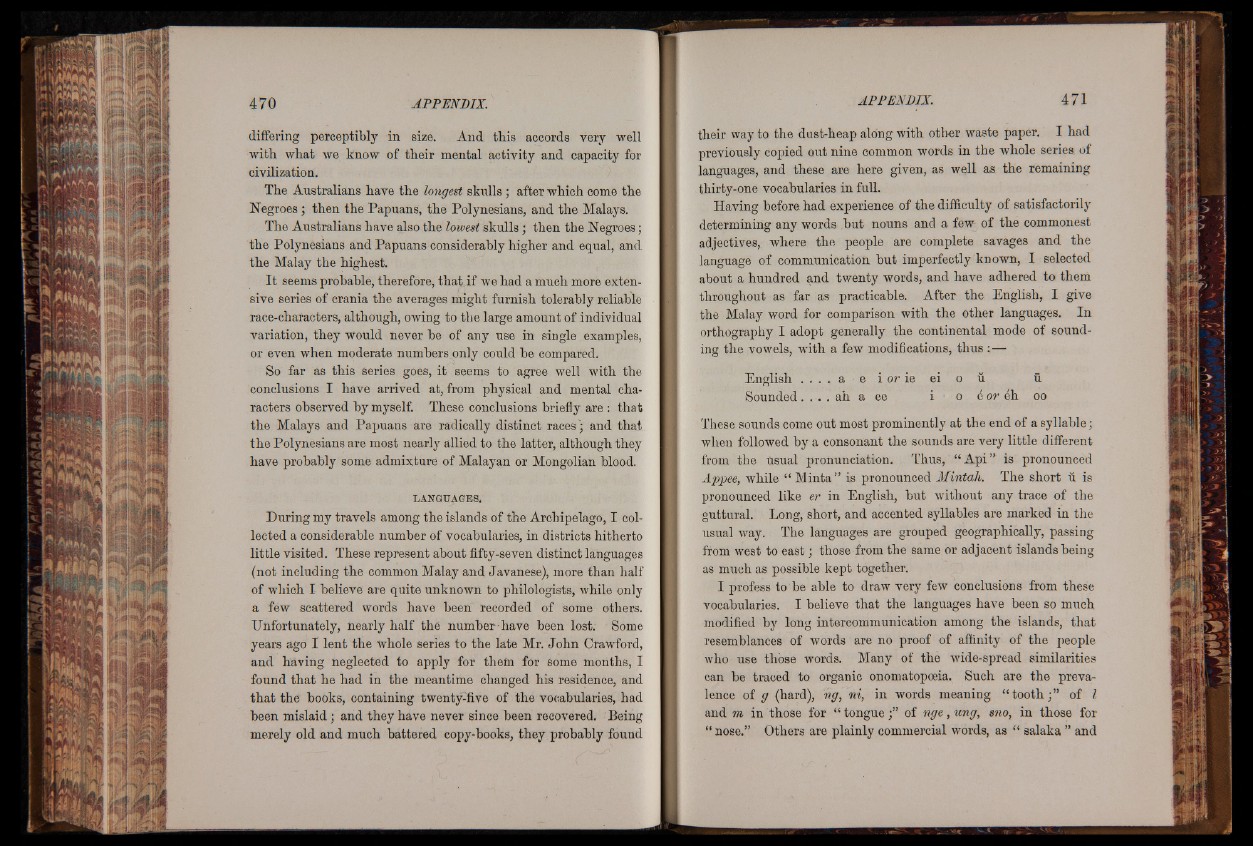
differing perceptibly in size. And this accords very well
with, what we know of their mental activity and capacity for
civilization.
The Australians have the longest skulls ; after which come the
Negroes ; then the Papuans, the Polynesians, and the Malays.
The Australians have also the lowest skulls ; then the Negroes ;
the Polynesians and Papuans considerably higher and equal, and
the Malay the highest.
It seems probable, therefore, that if we had a much more extensive
series of crania the averages might furnish tolerably reliable
race-characters, although, owing to the large amount of individual
variation, they would never be of any use in siDgle examples,
or even when moderate numbers only could be compared.
So far as this series goes, it seems to agree well with the
conclusions I have arrived at, from physical and mental characters
observed by myself. These conclusions briefly are : that
the Malays and Papuans are radically distinct races ; and that
the Polynesians are most nearly allied to the latter, although they
have probably some admixture of Malayan or Mongolian blood.
LANGUAGES,
During my travels among the islands of the Archipelago, I collected
a considerable number of vocabularies, in districts hitherto
little visited. These represent about fifty-seven distinct languages
(not including the common Malay and Javanese), more than half
of which I believe are quite unknown to philologists, while only
a few scattered words have been recorded of some others.
Unfortunately, nearly half the number have been lost. Some
years ago I lent the whole series to the late Mr. John Crawford,
and having neglected to apply for theln for some months, I
found that he had in the meantime changed his residence, and
that the books, containing twenty-five of the vocabularies, had
been mislaid ; and they have never since been recovered. Being
merely old and much battered copy-books, they probably found
their way to the dust-heap along with other waste paper. I had
previously copied out nine common words in the whole series of
languages, and these are here given, as well a3 the remaining
thirty-one vocabularies in full.
Having before had experience of the difficulty of satisfactorily
determining any words but nouns and a few of the commonest
adjectives, where the people are complete savages and the
language of communication but imperfectly known, I selected
about a hundred and twenty words, and have adhered to them
throughout as far as practicable. After the English, I give
the Malay word for comparison with the other languages. In
orthography I adopt generally the continental mode of sounding
the vowels, with a few modifications, thus :—
English . . . . a e i or ie ei o ü ü
Sounded. . . . ah a ee i o à or éh oo
These sounds come out most prominently at the end of a syllable ;
when followed by a consonant the sounds are very little different
from the Usual pronunciation. Thus, “ Api” is pronounced
Appee, while “ Minta” is pronounced Mintah. The short ü is
pronounced like er in English, but without any trace of the
guttural. Long, short, and accented syllables are marked in the
usual way. The languages are grouped geographically, passing
from west to east ; those from the same or adjacent islands being
as much as possible kept together.
I profess to be able to draw very few conclusions from these
vocabularies. I believe that the languages have been so much
modified by long intercommunication among the islands, that
resemblances of words are no proof of affinity of the people
who use those words. Many of the wide-spread similarities
can be traced to organic onomatopoeia. Such are the prevalence
of g (hard), ng, ni, in words meaning “ tooth;” of I
and m in those for “ tongue ;” of nge, ting, sno, in those for
“ nose.” Others are plainly commercial words, as “ salaka ” and